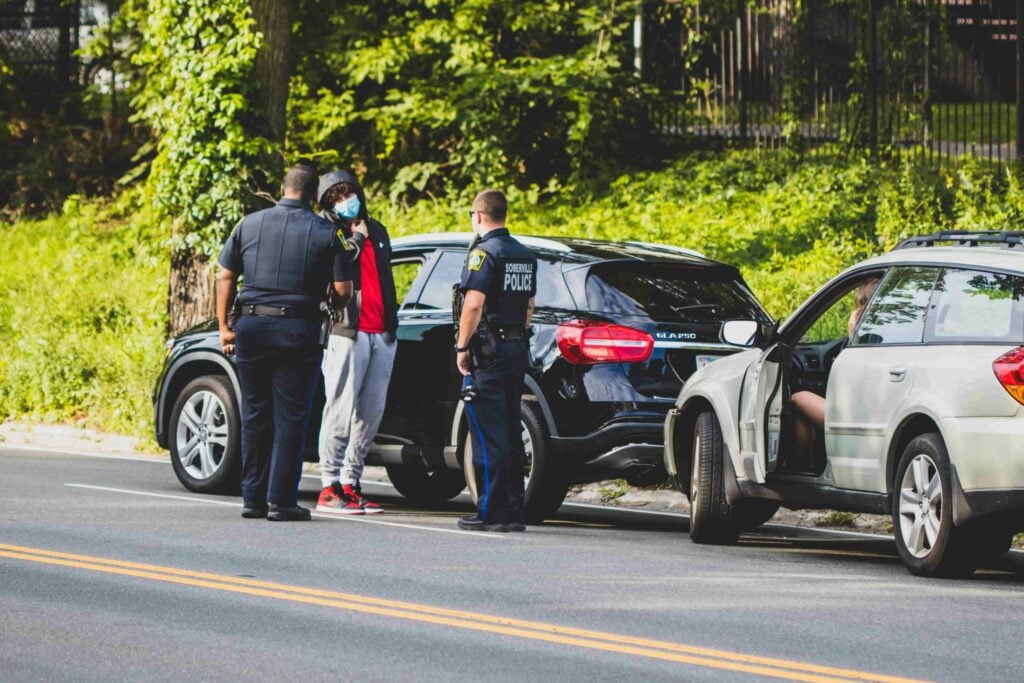If you or a loved one was injured in a Pennsylvania personal injury case, contact an attorney before doing anything else to protect your rights. In this article, we’ll explore the 5 biggest hurdles to winning Pennsylvania personal injury cases. At Spivak & Sakellariou, we are dedicated personal injury attorneys who work on a wide range of accidents. We can help you take the right steps following your accident to avoid being taken advantage of. Now, let’s delve into the challenges you may encounter when pursuing justice in a Pennsylvania personal injury case.
Hurdle 1: Establishing Fault and Liability
One of the main hurdles in any Pennsylvania personal injury case is establishing fault and liability. Establishing fault and liability is a foundational aspect of personal injury cases. Negligence forms the basis of personal injury claims. To establish fault and liability, you must prove that the at-fault party had a duty of care towards you, that they breached that duty, and as a direct result, caused your injuries or losses.
Elements of Negligence
To establish negligence, you generally need to demonstrate four critical elements:
- Duty of Care. Identify and establish that the at-fault party owed you a legal duty of care under the circumstances.
- Breach of Duty. Present evidence showing that the at-fault party failed to fulfill their duty of care.
- Causation. Prove a direct link between the defendant’s actions or omissions and the harm you suffered.
- Damages. Show that you incurred actual damages. These could be medical expenses, lost wages, property damage, or pain and suffering, caused by the accident.
Evidence and Documentation
Building a compelling case requires gathering and documenting evidence. This may include:
- Accident Reports. Obtain official reports, such as police reports, accident reconstruction reports, or incident reports. Any of these can contain crucial information about the incident.
- Witness Statement. Collect statements from eyewitnesses who can provide firsthand accounts of what transpired.
- Photographic Evidence. Document the scene, injuries, and property damage through photographs and, if applicable, videos.
- Medical Records. Secure your medical records, which help establish the link between the accident and your injuries.
- Expert Testimony. In complex cases, consider consulting with expert witnesses. These could be medical professionals or accident reconstruction experts. They can provide specialized insights and testimony.
Comparative Negligence
Pennsylvania follows a comparative negligence system. It allows you to seek compensation even if you share some degree of fault for the accident. However, your potential recovery may be reduced proportionally to your level of responsibility. Understanding how comparative negligence applies to your case is important. It will help to determine the amount of compensation you may receive.
Hurdle 2: Settlement Negotiations
Reaching a fair insurance settlement is a critical phase in many personal injury cases. Settlement negotiations serve as a way to resolve a personal injury claim outside of court. They involve discussions and, sometimes, formal offers and counteroffers between the parties. The goal is to arrive at a compensation amount that both parties find acceptable. This will save the time and expense of a trial.
Negotiation Process
Negotiations typically involve a series of offers and counteroffers between the parties. Your attorney will assess each offer and advise you to accept, reject, or counter. This process can go back and forth until both sides agree on a settlement amount or reach an impasse.
Factors Considered in Settlements
Several factors influence the settlement amount, including:
- Extent of Injuries. The severity and long-term impact of your injuries play a significant role in determining compensation.
- Medical Expenses. Past and future medical costs, including surgeries, therapy, and medications.
- Lost Income. If the injury resulted in lost wages or diminished earning capacity this will be considered.
- Pain and Suffering. Compensation may be awarded for physical and emotional pain and suffering caused by the accident.
- Property Damage. Costs related to repairing or replacing damaged property are included.
Mediation and Alternative Dispute Resolution
If negotiations stall, mediation, or alternative dispute resolution (ADR) methods may be pursued. A neutral third party, the mediator, facilitates discussions between the parties to help reach a resolution. Mediation can be a productive way to break impasses in settlement negotiations.
Signing a Release
Once a settlement is reached, both parties sign a release, which legally binds them to the agreed-upon terms. In exchange for the settlement amount, the injured party waives their right to pursue further legal action against the at-fault party for the same incident.
Advantages of Settlement
Settlement negotiations offer several advantages, including:
- Faster Resolution. Settlements can be reached faster than going to trial, saving time and money.
- Predictable Outcomes. Both parties have more control over the outcome compared to a trial, where a judge or jury decides.
- Reduced Stress. Avoiding a trial can lessen the emotional toll on the injured party.
Hurdle 3: The Trial Process
When settlement negotiations don’t work, a case may proceed to trial as a personal injury lawsuit. A trial is a legal proceeding where both parties, the injured party and the at-fault party present their cases before a judge or jury. The goal is to determine liability and fair compensation for injuries and damages suffered.
Types of Trials
There are two primary types of trials in personal injury cases:
- Jury Trial: In a jury trial, a panel of jurors typically consists of 6 to 12 individuals. They listen to the evidence presented by both sides and render a verdict. The jury decides on issues of fact, whether the defendant was negligent. They also decide on the amount of compensation the plaintiff should receive.
- Non-Jury or Bench Trial: In a non-jury or bench trial, the case is heard and decided by a judge alone. The judge evaluates the evidence and legal arguments presented by both parties and issues a verdict.
Burden of Proof
In personal injury cases, the burden of proof rests on the plaintiff (injured party). This means the plaintiff must establish, by the evidence, that the defendant’s negligence or misconduct was more likely than not the cause of the injuries and damages.
Outcomes of a Trial:
The trial can result in several possible outcomes:
- Verdict for Plaintiff: If the judge or jury finds in favor of the plaintiff, the defendant may be ordered to pay a specified amount in damages.
- Verdict for Defendant: If the judge or jury determines the defendant is not liable, the plaintiff receives no compensation.
- Partial Verdict: In some cases, the judge or jury may find both parties partially at fault and apportion liability accordingly.
Appeals
Following a trial, either party has the right to appeal the verdict if they believe legal errors occurred during the trial. The appeals process involves reviewing the trial record and presenting arguments to a higher court.
Hurdle 4: Tort Exceptions
A tort is a civil wrong that causes harm to someone else, and personal injury cases often involve tort claims. The injured party seeks compensation from the at-fault party for the non-economic harm they suffered due to negligence or intentional misconduct.
Tort Exceptions in Pennsylvania
Pennsylvania has specific tort exceptions that can affect personal injury claims, including:
- Limited Tort Option. Pennsylvania allows individuals to choose between limited tort and full tort coverage when purchasing auto insurance. Under limited tort, policyholders pay lower premiums. However, their ability to seek compensation for non-economic damages is limited. This is unless the injuries meet specific criteria. Full tort coverage allows for broader compensation for non-economic damages.
- Verbal Threshold for Tort Claims. Pennsylvania uses a “verbal threshold” or “limited tort threshold” for tort claims involving motor vehicle accidents. This threshold requires that an injury fall into one of several categories. These categories include death, serious impairment of body function, and permanent disfigurement. If your injury doesn’t meet these criteria, you may be limited in the damages you can pursue.
- Tort Immunity. Certain entities like government agencies and employees, may enjoy tort immunity under Pennsylvania law. This means that you may not be able to sue these entities for personal injury claims in some situations. However, exceptions exist, and you may still pursue compensation under specific circumstances.
Limited Tort vs. Full Tort Coverage
The choice between limited tort and full tort coverage can have a significant impact on your ability to seek compensation after a car accident. Limited tort may provide lower insurance premiums, but it restricts your ability to recover non-economic damages. This is true unless your injuries meet the criteria specified in the policy. Full tort coverage allows for more comprehensive compensation, but premiums are generally higher.
Meeting the Limited Tort Threshold
To seek non-economic damages under limited tort coverage, your injuries must meet the criteria established by Pennsylvania law. These criteria typically include serious bodily injury, permanent disfigurement, or death.
Hurdle 5: Statute of Limitations
The statute of limitations is a crucial legal concept that governs the time within which a legal action must be filed. In personal injury cases, it specifies the period within which you must start legal proceedings against the defendant.
Purpose of the Statute of Limitations
The statute of limitations serves several important purposes:
- Encouraging Timely Resolution. It encourages parties to pursue legal actions immediately. This ensures that cases are resolved while evidence is still fresh and witnesses’ memories are reliable.
- Protecting Defendants. It prevents plaintiffs from indefinitely threatening legal action against defendants. This ensures that potential liabilities have an endpoint.
- Legal Finality. Once the statute of limitations expires, the injured party loses the right to file a lawsuit related to the specific incident.
Statute of Limitations in Personal Injury Cases:
The statute of limitations for personal injury cases can vary depending on the jurisdiction and the type of injury. In the United States, each state sets its own statutes of limitations for various types of cases. For example, in Pennsylvania:
- Most personal injury cases have a two-year statute of limitations. This includes those arising from car accidents or slip-and-fall incidents.
- Medical malpractice cases have a two-year statute of limitations. However, there are exceptions that can extend the deadline.
When Does the Clock Start Ticking?
The statute of limitations clock usually starts ticking on the date of the injury or when the injury was discovered. This is known as the “discovery rule”. Some exceptions may apply, particularly in cases involving latent or long-term injuries.
Importance of Timely Action
Failing to file a lawsuit within the applicable statute of limitations can have consequences. When the statute of limitations expires, you lose the legal right to seek compensation for your injuries. On top of that, your case may be dismissed by the court.
Your Trusted Advocates in Pennsylvania Personal Injury Cases
The landscape of Pennsylvania personal injury cases can be complicated. This is why having a dedicated and experienced advocate by your side can make all the difference. At GSAS, our team of dedicated personal injury attorneys is here to help. We are committed to ensuring that your rights are protected and that you receive the compensation you deserve. We understand the intricacies of the statute of limitations, the challenges posed by tort exceptions specific to Pennsylvania personal injury cases, and the nuances of settlement negotiations and trials in this jurisdiction.
With our experience and commitment, we can guide you through the legal process. We can advocate on your behalf toward a favorable outcome. You don’t have to deal with the hurdles of Pennsylvania personal injury cases alone. Contact GSAS to be your trusted partner in seeking justice and the compensation you need to move forward.


